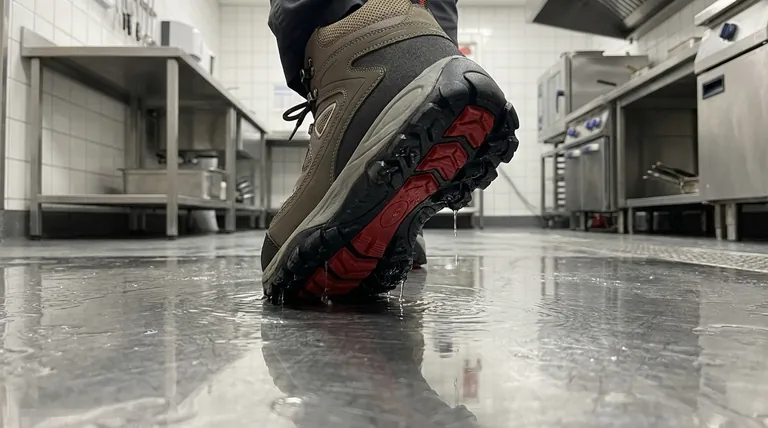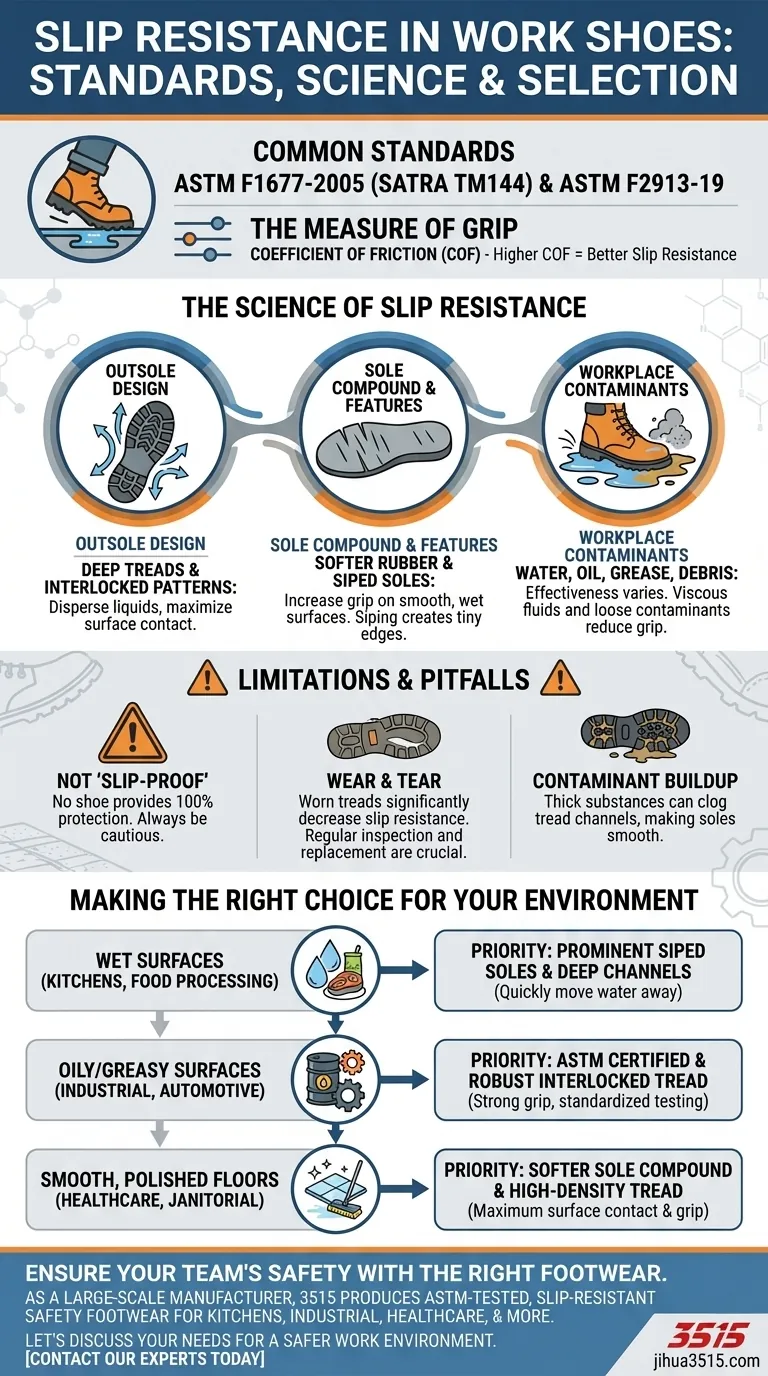The most common standards for slip resistance in work shoes are ASTM F1677-2005 (also known as SATRA TM144) and ASTM F2913-19. Footwear that has been tested and certified against these standards provides a reliable measure of traction for workplaces with slippery floor conditions.
While industry standards provide a crucial benchmark, true slip resistance is a function of three interconnected factors: the shoe's outsole design, the specific contaminants on the floor, and the cleanliness of the work environment.

What Makes a Shoe Truly Slip-Resistant?
Understanding the design principles behind slip resistance allows you to look beyond marketing claims and evaluate a shoe's functional safety. It's about how the shoe interacts with the surface at a micro-level.
The Role of the Outsole Design
The physical pattern of the sole is your first line of defense. Effective designs feature deep treads or an interlocked pattern.
This design maximizes the surface area in contact with the ground while creating channels to disperse liquids like water and oil away from the sole's point of contact.
The Importance of Sole Compound and Features
The material of the sole is just as important as its shape. Softer rubber compounds often provide a better grip on smooth, wet surfaces.
A key feature to look for is siped soles. These are extremely thin slits cut into the outsole that increase traction by creating thousands of tiny gripping edges, which is especially effective on wet floors.
How Industry Standards Are Measured
The ASTM standards provide a standardized method for measuring a shoe's grip.
These tests calculate the coefficient of friction (COF), which is a numerical value representing how much grip a shoe has on a specific surface, such as wet tile. A higher COF rating indicates better slip resistance.
Understanding the Limitations and Pitfalls
Even the highest-rated slip-resistant shoe has limitations. Acknowledging these realities is essential for maintaining a safe work environment.
No Shoe is "Slip-Proof"
It is critical to understand that no footwear can provide 100% protection against slips in all conditions. The term is "slip-resistant," not "slip-proof."
The Critical Impact of Contaminants
The effectiveness of a slip-resistant sole degrades significantly when faced with viscous fluids like grease or oil, or loose contaminants like dust and debris.
The shoe's tread is designed to channel away thin liquids like water, but thicker substances can clog the channels, rendering the sole dangerously smooth.
The Factor of Wear and Tear
Over time, the tread pattern on any shoe will wear down. As the tread depth decreases, so does its ability to disperse liquids and grip the floor.
Regularly inspect your footwear for signs of a worn-out sole and replace them when the tread pattern is no longer distinct.
Making the Right Choice for Your Environment
Your specific workplace hazards should dictate your choice of footwear. Use these guidelines to select the appropriate shoe for your needs.
- If your primary focus is wet surfaces (e.g., kitchens, food processing): Prioritize shoes with prominent siped soles and deep tread channels designed to quickly move water away.
- If your primary focus is oily or greasy surfaces (e.g., industrial, automotive): Insist on footwear that is explicitly certified to ASTM standards and features a robust, interlocked tread pattern.
- If your primary focus is smooth, polished floors (e.g., healthcare, janitorial): Look for a combination of a softer sole compound and a high-density tread pattern for maximum surface contact and grip.
Choosing the right footwear is a foundational step in ensuring your safety on the job.
Summary Table:
| Key Factor | Importance for Slip Resistance |
|---|---|
| Outsole Design | Deep treads and interlocked patterns disperse liquids and maximize grip. |
| Sole Compound | Softer rubber and siped soles provide better traction on wet, smooth surfaces. |
| Industry Standards (e.g., ASTM) | Certifications provide a measurable coefficient of friction (COF) for reliable safety. |
| Workplace Contaminants | Shoe effectiveness varies with hazards like water, oil, grease, or debris. |
| Wear and Tear | Worn-down treads significantly reduce slip resistance; inspect and replace regularly. |
Ensure your team's safety with the right footwear. As a large-scale manufacturer, 3515 produces a comprehensive range of ASTM-tested, slip-resistant work shoes and boots for distributors, brand owners, and bulk clients. Our production capabilities encompass all types of safety footwear designed for kitchens, industrial settings, healthcare, and more. Let's discuss your specific needs and create a safer work environment together. Contact our experts today for a consultation!
Visual Guide

Related Products
- Safety Footwear Wholesale Manufacturer for Custom OEM/ODM Production
- Advanced KPU Athletic Safety Shoe with Steel Toe Cap Anti-Slip Rotary Lacing System
- Premium Suede Sport Safety Shoes for Wholesale & Bulk Orders
- Wholesale Premium Waterproof Nubuck Safety Shoes Boots
- Durable Rubber-Soled Utility Shoes for Wholesale & Custom Brand Manufacturing
People Also Ask
- How do safety shoes contribute to cost savings for companies? A Strategic Investment in Risk and Cost Management
- What do heavy duty boots do? Protect Your Feet in Demanding Work Environments
- What are OSHA approved shoes? Understanding the Correct Standards for Workplace Safety
- What are the differences between steel toe, composite toe, and alloy toe Wellington boots? Choose the Right Safety Toe for Your Job
- What are the cultural perspectives on wearing shoes in the house? A Guide to Home Etiquette & Hygiene



















